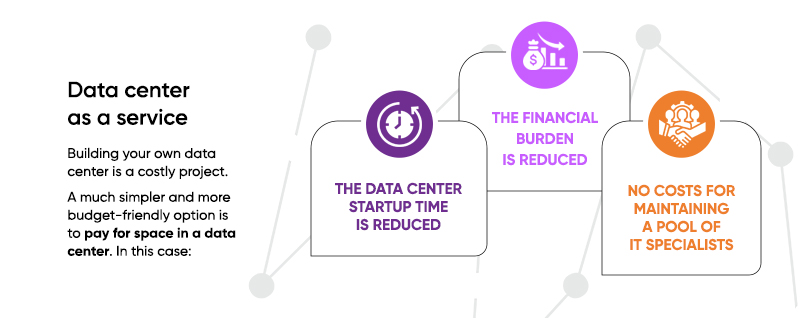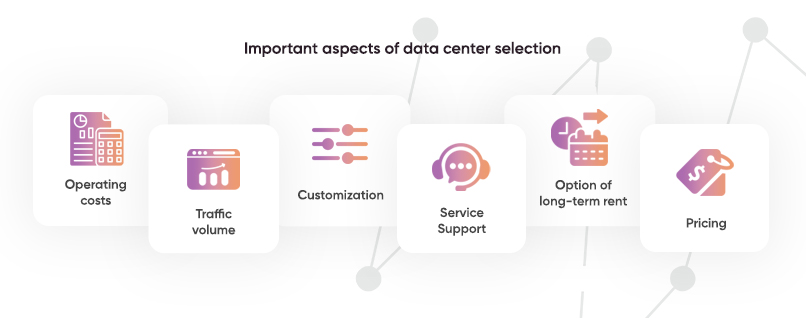Contents
Building your own data center is a costly project which can be implemented only by large companies that are ready to make serious investments in construction and hire employees with high competences. A much simpler and more budget-friendly option is to pay for space in a data center, placing your own (or rented) hardware there. In this case, the data center startup time is reduced, and the financial burden on the company is also reduced due to hardware depreciation and the absence of costs for maintaining a pool of IT specialists.

The service is in demand by clients who cannot deploy required hardware at their own site for various reasons. For example, they do not have the required amount of space, lack the necessary engineering systems, do not have enough free funds, need to reduce capital investments in IT infrastructure with the transition to the OpEx model, do not have enough channel bandwidth, have issues with attracting qualified IT specialists or need to free them from managing the data center to solve more pressing tasks.
What is a data center as a service (DCaaS)
Clients rent or access a data center from a provider that offers them the infrastructure for deployment of their server hardware and its own computing resources. A set of services for placing IT infrastructure and adjusting it to the needs of clients in a server center on a remote basis, providing tools for data management and server optimization: this is the DCaaS (data center as a service) service model.
Data center as a service is the provision of both physical facilities and data center infrastructure for rent. The DCaaS service model resembles renting an office with all communications, fully “customized” for the client. The provider offers hardware and space, arranging it in accordance with the client’s wishes, for example, equipping it with the necessary sensors and management tools to control changes.
DCaaS service provider also offer virtual expansion for data centers, even if the data center does not have free space, additional power supply, required engineering systems or free capital. In this case, it is a remote rent of a data center managed remotely via an external network.
On the other hand, the advantages are much greater. A tenant company may no longer have to invest in equipment and staff, but can use the data center to handle a portion of its applications. Payment in Data center service model means “pay-as-you-use,” with rapid increase or decrease of services required at a given time.
Providers not only offer a set of tools for service automation but also allow integration of customized client tools via APIs, support server architecture without installed OS and applications with direct access to hardware.
What services you can get when renting a data center
Data centers offer a wide range of services when they provide their space and facilities for rent.
- Placement of servers in racks, 19-inch cabinets with individual locks, space allocation (most often they offer from 100 to 900 square meters) with cells according to customer specifications. Usually they offer a power allocation up to 8 kW, separate power meters, n+1 backup power supplies, air conditioning, fire suppression, security systems (strict authorization and biometrics for access control, 24/7 security and error monitoring).
- Colocation. Servers are placed on rented data center sites on a self-service basis (acquisition, delivery, configuration, maintenance, and disposal of hardware are entirely the responsibility of the client). The main advantage of colocation is the reduction of operating costs for IT infrastructure support.
- Consulting services (consulting, critical infrastructure migration planning, creation of project roadmaps, IT infrastructure optimization, cyber security, backup, load balancing, etc.).
- Hardware maintenance (purchase, installation, long-term rent with subsequent purchase (leasing/HaaS), maintenance, and utilization). Placing a server rack and your own or rented hardware in a data center, you can draw a service contract under which the vendor undertakes to deliver new components in case of failure of any hardware. The provider on the same terms, on payment of a small insurance (about €30), provides post-warranty service with replacement of faulty components at the expense of the service provider.
- IT infrastructure administration (implementation of any services, creation of detailed documentation, use of ticketing system, installation and standardization of software and hardware, updates, optimization, troubleshooting of local issues, including remotely).
- The “Remote hands” service to maintain infrastructure with different contractual conditions (terms and conditions, and speed of response).
- Connecting common infrastructure within a data center, between different data centers of the same provider, using technologies for transmitting different information channels over the same fiber at different carrier frequencies (CWDM) and wavelength division with dense wavelength division multiplexing (MWDM) based on CWDM.
- Optionally, a data center is ready to provide solutions under any model (IaaS, HaaS, SaaS, MaaS, NaaS, SECaaS, DaaS, CaaS, DBaaS, XaaS).
By renting space in a data center, you can transfer the creation of turnkey projects to the owner of the infrastructure, up to the implementation of any solutions, including custom ones according to the client’s requirements. In this case, all related work, starting from architecture planning and up to server equipment maintenance, falls on the provider’s shoulders. The client gets rid of the headache and may not get into solving individual issues.
Direct renting of space for a server and/or a server rack in the data center includes the following:
- rent of space in the equipment room of the data center for placement of the client’s physical hardware, connection to switch ports with the selected bandwidth;
- organization of safe operations of IT hardware in the server center;
- quick response to any incidents by notifying the client.
The calculation of the cost of renting, for example, a server in a data center, is a combination of the following factors:
- server parameters (number of cores, RAM size, speed, size of the disk subsystem);
- ports capacity;
- traffic volumes;
- cost of software/licenses (if not included in the service package);
- selection of additional services (extended functionality, service desk, possibility of visiting the data center, etc.).

You can reduce rental costs for high-density servers by selecting compact blades. Their use allows you to place more than 100 servers in a 42-unit rack. If you purchase 24/48-core processors for the blades, you can get a super-performance computing system in an ordinary rack. To compensate for their low disk speed, it is enough to connect external data storages.
Important aspects of data center selection
Selecting a data center starts with examining the uptime guarantees (it is enough to know that the data center complies with Tier 3 level and 99.82% SLA availability). In this case, access to resources will be uninterrupted, and in case of failure, it will take minimum time to eliminate the consequences.
The vast number of offers, especially in large European Internet hubs, allows you to find the most suitable offer for your company. Having performed a comparative analysis of more than 20 major providers in Europe, we have compiled a checklist that helps you to find your data center and establish long-term and mutually beneficial cooperation with it.
Selection of a data service provider in Europe should be based on maximizing security, reliability and fault tolerance of the IT infrastructure, and ability to use hardware that perfectly matches business needs of the client.

Operating costs
This is the first thing to calculate when you are preparing to rent a data center. Data center maintenance costs are always high. To large extent, the costs consist of high cost of electricity for business (the highest cost in Europe is in Italy – €0.58 per kWh, in Germany the average is €0.49 per kWh), maintaining an optimal cooling system, investments in construction of a special architecture of the data center building, etc.
The best option is when data center employees provide consulting services, helping to prepare for migration up to providing free transportation of hardware from neighboring countries, and assessing the possible risks. In this case, the client will understand what he will face in the future, will be able to assess the possibility of implementation of hybrid solutions for the company’s resources and rented capacity, and will be able to adjust existing solutions to the task or existing infrastructure.
Traffic volume
A significant percentage of data centers have traffic limits. For example, the client may be provided with a channel with a fixed bandwidth of 100 megabits or 1 gigabit including incoming and outgoing traffic. Therefore, you should find out about this in advance, and, if possible, to select such data center that does not limit your traffic volume, and the price and speed are fixed without additional fees. For companies with small traffic volume this criterion is not critical.
Customization
It’s not enough to rent a data center or a rack in a data center, it’s important to bring the hardware there, set it up, launch and configured it. Many providers insist on standardizing hardware and using default server configurations. But their clients sometimes require implementation of custom solutions. It is extremely difficult to draw contracts with providers and organize logistics for hardware delivery. It is much more pleasant when these worries are taken care of by provider that is able not only to calculate resources and configure hardware but also to order, deliver, and launch it, connecting it to the existing data center infrastructure.
By finding a data center whose staff has a quick and flexible response to the client’s requirements and whose work can be done on a turnkey basis, including processing of all the paperwork, the client will save his nerves, time and, ultimately, the money. This is due to the fact that otherwise he will have to pay for many related services: from hardware configuration to logistics and customization.
Service Support
Usually, data centers prefer to maintain their own hardware that they rent out. But clients often need to work on their own servers for current tasks. In this case, there are issues with maintenance and warranty for hardware replacement in case of malfunction.
If it is required to rent a space for a server in a data center and install hardware owned by the company, it is necessary to look for provider that is willing to take on maintenance of any, even obsolete, model of server. In this case, you can draw a contract for both: warranty service by the vendor and post-warranty maintenance by the provider. If you pay a small monthly fee (from €30 per unit), the data center (service provider) will replace any failed hardware free of charge, regardless of its cost.
A great advantage of a data center is the availability of personal and account managers capable of solving engineering issues via ticketing system and knowledgeable about technical features of the client’s hardware (client’s requirements). This is especially important for companies that always work with IT infrastructure and extremely sensitive to the constant change of provider’s specialists to whom they have to explain typical issues with their hardware each time a new specialist from provider’s staff appear.
Option of long-term rent with the right of redemption (leasing)
Not all companies can afford to buy a new hardware. However, it is possible to purchase a server for deployment on the rented space in the data center in installments. Often this option might be more profitable for a company, because it is not necessary to pay a large sum all at once. It is enough to pay no more than 3% of its actual cost (it is about $400, if you take into account the server for €20, 000) and sign a contract for service maintenance with the data center.
Further payment is fixed, i.e. there is a repayment of the loan body, not interest, as a result of which there is no overpayment for the client. The cost of the server is fixed at the time of purchase, the payment is divided in equal installments for the entire rental period, and after its completion the client can buy the server at the residual value. While the server is rented (long-term rent with the right of redemption/HaaS model), its capacity is resold or subleased. And the generated income is used, among other things, to repay monthly payments.
DCaaS: everything you need to know about renting a data center
Write us a message to get additional information.
or book a free consultation
Pricing
A standard data center rental contract is signed for a year. Afterwards, the rental cost may grow. It is better to select a service provider that offers fulfillment of the contract for any duration of time on equal terms. At the same time, when signing a contract for three years or more, its cost is fixed. As a result, the cost of colocation services and technical works do not increase. The only item that remains dynamic is energy cost.
To make an informed choice and rent a data center, we offer you to use the guide, based on the results of our analysis of more than 20 European data centers.

Article author
Olga Boujanova
Consultant on server hardware and data center organization
